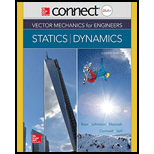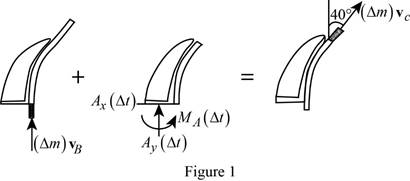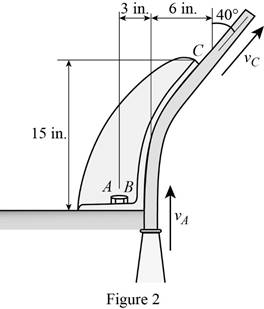
Concept explainers
The force couple system that must be applied at A to hold the vane in place.
Answer to Problem 14.112RP
The x component of force
The y component of force
The couple
Explanation of Solution
Given information:
The nozzle discharges (Q) water at the rate of
The stream of the water moves with a velocity (v) of magnitude is
Assume unit weight of the water
Assume the acceleration due to gravity (g) as
Calculation:
Convert the gallons per minutes to cubic feet per second.
Calculate the rate of the water discharge
Substitute
Express the velocity of water
Express the velocity of water
Consider right side and upward as positive.
Show the impulse momentum equation diagram as in Figure (1).

Calculate the x component of force
Substitute
Substitute
Calculate the y component of force
Substitute
Substitute
Show the given nozzle system as in Figure (2).

Consider clockwise as negative.
Calculate the couple applied
Substitute
Substitute
Therefore, the x component of force
Therefore, the y component of force
Therefore, the couple
Want to see more full solutions like this?
Chapter 14 Solutions
Connect 2 Semester Access Card for Vector Mechanics for Engineers: Statics and Dynamics
 Elements Of ElectromagneticsMechanical EngineeringISBN:9780190698614Author:Sadiku, Matthew N. O.Publisher:Oxford University Press
Elements Of ElectromagneticsMechanical EngineeringISBN:9780190698614Author:Sadiku, Matthew N. O.Publisher:Oxford University Press Mechanics of Materials (10th Edition)Mechanical EngineeringISBN:9780134319650Author:Russell C. HibbelerPublisher:PEARSON
Mechanics of Materials (10th Edition)Mechanical EngineeringISBN:9780134319650Author:Russell C. HibbelerPublisher:PEARSON Thermodynamics: An Engineering ApproachMechanical EngineeringISBN:9781259822674Author:Yunus A. Cengel Dr., Michael A. BolesPublisher:McGraw-Hill Education
Thermodynamics: An Engineering ApproachMechanical EngineeringISBN:9781259822674Author:Yunus A. Cengel Dr., Michael A. BolesPublisher:McGraw-Hill Education Control Systems EngineeringMechanical EngineeringISBN:9781118170519Author:Norman S. NisePublisher:WILEY
Control Systems EngineeringMechanical EngineeringISBN:9781118170519Author:Norman S. NisePublisher:WILEY Mechanics of Materials (MindTap Course List)Mechanical EngineeringISBN:9781337093347Author:Barry J. Goodno, James M. GerePublisher:Cengage Learning
Mechanics of Materials (MindTap Course List)Mechanical EngineeringISBN:9781337093347Author:Barry J. Goodno, James M. GerePublisher:Cengage Learning Engineering Mechanics: StaticsMechanical EngineeringISBN:9781118807330Author:James L. Meriam, L. G. Kraige, J. N. BoltonPublisher:WILEY
Engineering Mechanics: StaticsMechanical EngineeringISBN:9781118807330Author:James L. Meriam, L. G. Kraige, J. N. BoltonPublisher:WILEY





